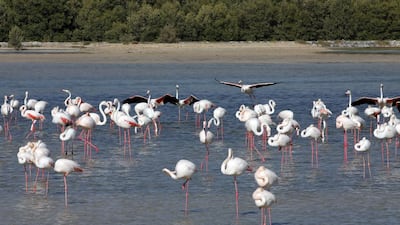ABU DHABI // Citizen scientists have helped environment chiefs to map the emirate’s entire 90,000 square kilometres of land and marine habitats.
But the Environment Agency Abu Dhabi needs more, from amateurs such as the students who began to take part six months ago, to professional environment consultancies.
They can do this through a mobile application called Collector for ArcGIS, information from which will help in forming environmental policy.
“When a member of the public is out for fieldwork or with their family in the desert or ocean, they can observe and record signs of wildlife or fauna,” said Dr Shaikha Al Dhaheri, executive director of biodiversity at Ead. “In the app, the data will be transmitted to Ead.
“It is about building collected data through the students, community and researchers rather than only depending on us to collect this data. When we engaged the students, it was like having 10 apps instead of two.”
As environments change over time and animals move, so will the interactive habitat map, with the public’s help.
From engineers mapping oil pipeline sites to residents camping for the weekend, anyone can download the app and use it to take notes, which are then uploaded to Ead’s database and used for reference.
Called “beatty”, which means “my environment” in Arabic, the map on Ead’s website is said to be 90 per cent accurate.
The map was made possible through advanced image-processing techniques and validation through field surveys.
“This project helps us get information for decision-makers so that they can say ‘these areas are important, don’t touch it’,” said Anil Kumar, director of environment information management.
Ead has been collecting information since it was created in 1996, but Mr Kumar said this was the first time it had combined data for broader decisions.
“Combining this information, you can find the best suitable areas to ensure that these areas are preserved and protected because development is happening at a very rapid scale,” he said. “We want to make sure that these areas are not put under development.”
Mr Kumar said the information being updated through the app would give Ead a wealth of data it could use to update the map every two years.
“As soon as you capture that information you can upload it to our database. So we get this information then we validate it, because who knows? If someone sees a cat they might say it’s a leopard,” he said, laughing. “So we need to verify that.”
Razan Al Mubarak, secretary general of Ead, said the map would allow the emirate to continue sustainable development in line with Abu Dhabi 2030, and would have other important uses.
“The habitat map will also serve as an invaluable tool while responding to emergencies, such as oilspills, and help responders identify environmentally sensitive areas that are in need of immediate protection,” Ms Al Mubarak said.
“We really are turning data into knowledge and the power to make better and more informed decisions.”
nalwasmi@thenational.ae

